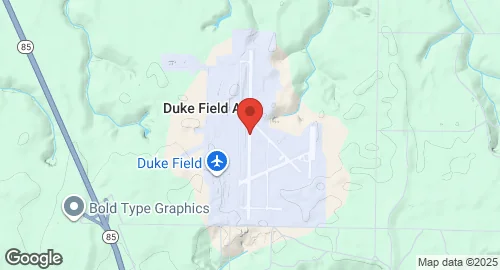Duke Field
Summary
| Operating Country | 🇺🇸 United States |
| Location | 🇺🇸 United States |
| Status | ◉ Active |
| Usage | Military only |
| Year built | 1941 |
| Operating Organization | US Air Force Reserve |
| Units |
|
Description
Duke Field, also known as Eglin AFB Auxiliary Field #3, is a military airport located near Crestview, Florida. Construction began on January 23, 1941, with the first building foundations laid on February 15, 1942. The field was used as a training base by the Doolittle Raiders in 1942. In the 1950s, it became home to the 3205th Drone Group, which operated radio remote-controlled B-17s and F-80s for gunnery and missile practice, and for nuclear test program data collection. During the Cold War, Duke Field facilitated operations related to the Bay of Pigs Invasion, including the preparation of aircraft for Cuban exile aircrews. The Central Intelligence Agency's air arm, the Development Projects Division, operated from Duke Field from late 1960 to mid-1961.
In August 1970, the Joint Contingency Task Group used Duke Field facilities for US Army Special Forces training during Operation Ivory Coast. On July 30, 1971, the 919th Tactical Airlift Group (919 TAG) was activated at Duke Field with C-130A Hercules aircraft. This unit converted to a special operations mission on July 1, 1975, becoming the 919th Special Operations Group (919 SOG), operating AC-130 Spectre gunships. In 1980, Duke Field was used for training related to Operation Credible Sport. The 919 SOG was redesignated as the 919th Special Operations Wing (919 SOW) in 1992, and in 1995, it transitioned to MC-130E Combat Talon I and MC-130P Combat Shadow aircraft. The 919 SOW currently operates MQ-9 Reaper, U-28A Draco, and C-146A Wolfhound aircraft, with the C-145A Combat Coyote fleet retired in December 2022.
Duke Field is primarily an Air Force Reserve Command (AFRC) installation, hosted by the 919th Special Operations Wing, which is operationally gained by Air Force Special Operations Command (AFSOC). The installation includes its own air traffic control tower, security forces, fire protection, instrument landing system, and support infrastructure. It has two asphalt runways: 18/36 measuring 2,446 meters (8,025 ft) and Assault Strip 180/360 measuring 1,066.8 meters (3,500 ft). The field is named for 1st Lt Robert L. Duke, who died in an aircraft crash in 1943.
